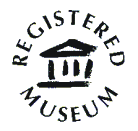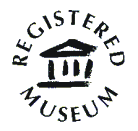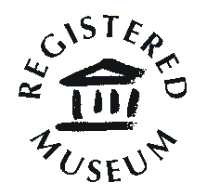

Newsletter
Issue 59 August 2007


~~~ NEWSDESK ~~~
Table of contents
Newsdesk, and dates for your diary 2
Museum Update - 4
Merton Abbey Mills update 9
House Mill 7
Mill 44 Update 10
The First Public Railway 12
Angling Diversions 13
Visits to the Museum have been good during the summer months. We have had two school visits for Textile Workshops from St Mark's Primary School and Merton Park Primary School and two Adult Groups, all of which were successful.
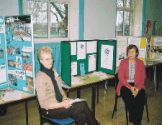 Sheila and Meg attend the
Volunteers Fair at Vestry
Hall
Sheila and Meg attend the
Volunteers Fair at Vestry
HallIn June a party from "Railway Ramblers" visited us as part of their investigation into the route of the Surrey Iron Railway. They arrived about midday and met Meg, Eric and myself for a guided tour of the Museum exhibits. Eric had arranged a display of information about the Surrey Iron Railway for them to see as of course this subject is one of his special interests.
In July we were pleased to meet a group from the Surrey Industrial History Group at Morden Hall Park From there we led them on a guided walk along the River Wandle, noting mill sites along the way. They were interested to see Morden Snuff Mill and Ravensbury Mill. After a tour of the Museum they went on their way.
Thanks to all the volunteers who gave up their Saturdays to help on these occasions.
Volunteers
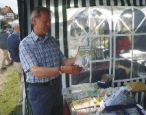 Tone Drakeford visits us
at Wimbledon Fair
Tone Drakeford visits us
at Wimbledon FairWe were sorry to lose Mavis Munt as a regular volunteer in the Museum on Wednesday afternoons and we thank her very much for her dedicated help over the past year. However Mavis has agreed to help us on a temporary basis to fill in when regulars are away, and will still come to our Vo1unteer lunches and events. We are pleased to welcome student volunteer Kate Evans who will help us in her vacations and is particularly interested in archival work.
Outreach
We were happy to participate once again at "A Country Affair" 3-day event at Morden Hall Park in May. This year National Trust had no space for us, so we had to pay £150 for the stall. We had very good facilities and although we did not make as much money as in previous years, that was more to do with the weather, and it was felt to be a worthwhile event which promoted the Museum.
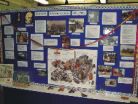 The Young’s Display
The Young’s DisplayIn June we once again had a stall at the Wimbledon Village Fair which was an enjoyable and profitable occasion. The day went extremely well until 4pm, when a sudden and violent cloudburst cleared the site of visitors, and left Mary Meg and Nicholas holding onto the gazebo to prevent it being blown away and doing their best to protect the stock. Luckily the damage was minimal.
Events
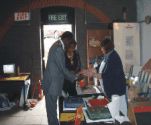 The Mayor visits Mary’s
stall during the Wandle
Valley Festival
The Mayor visits Mary’s
stall during the Wandle
Valley Festival
The opening of the new Exhibition Young's - End of an Era on June 16 was a successful day. The display, designed and mounted by volunteer Curator Meg Thomas with help from Eric Shaw, was opened by the Mayor of Merton, Cllr John Dehaney. Many members, friends and Councillors attended and some partook of a glass of Young's Ale supplied by The Cricketers pub, Mitcham.
We also participated in the Wandle Valley Festival on June 24th. The Museum was open in the afternoon and Mary Hart was busy all day at Merton Abbey Mills doing Printing Workshops in the Chapter House.
Members' Events A very interesting and successful outing took place in July when members and friends visited The House Mill at Bromley-by-Bow (see Article by Eric Shaw).
Dates for your Diary
- Tuesday 18th September: we will be participating again in the Celebrating Age festival for the Over 50s. The Museum will be open from 2pm and there will be a Guided Tour and Printing Workshop. Book your place - ring the Museum on 020 8648-0127 or e-mail us at curator@wandle.org.
- Thursday 1st November: Annual General Meeting at Raynes Park Library Hall at 7.30pm. Speaker John Phillips. Heritage Projects Manager for the London Borough of Sutton, on Houses and Gardens of the Upper Wandle. We hope to see as many of you as possible at the A.G. M. Details available nearer the time.
Sheila Harris August 200
Curatorial Report
Meg Thomas Reports:
Accreditation
As most of you will know we are a registered museum. Registration is now being updated to Accreditation. All museums are being invited to become accredited and we have received our invitation. The forms have to be returned by November, but of course, in these modern times we can fill in our form on line. Athough this means much of the form filling consists of ticking boxes we still have to be able to produce the relevent documents.
Sheila, Jackie, Eric and I have attended workshops on Accreditation, many of them appeared quite overwhelming but thankfully we have a very helpful and encouraging MDO(Museums Development Officer), Kate Hebditch. .
As we have already produced documentation for registration the task is mainly a case of updating this, but still quite a major undertaking. There have been some changes in the demands, especially reguarding security and the purchasing of stolen or forged artifacts. These areas, thankfully, are more the concern of the larger museums.
The biggest task facing us is the digitisation of the information we hold in the museum. For this we need a new computer and the right program. We do not need to have this done by November, which is a relief, but we have to have this as part of our forward planning. We still needed two forms of recording, the Day Book was one and as Jackie has created a card index of names associated with the mills that could be counted as the second one.
One other addition to the requirements is a cleaning regime, at least putting that document together wasn't too taxing.
School Visits
These are usually very enjoyable, and as retired teachers it allows Sheila and myself to keep in touch with the good part of teaching, contact with children, but to escape the now ever present paper work and targets!
The schools visit us as part of their local history work, often combined with art especially William Morris. W.Morris's style still appeals to children and to their love of colouring even in this day and age of computer games.
The visit begins with a short talk and a video of block printing, the first time the block printer lifts the block and reveals the pattern on the test paper it never fails to bring a gasp of delight.
This is followed by a visit to the museum. The class is divided into two groups.
One group tours the museum
 John Hawks, Lionel Greene, Pat Miller and
Marcus Beale at the local launch of the new
Museum of London publication ‘The
Augustinian Priory of St Mary, Merton,
held here by Pat Miller, co-author with
Dave Saxby. John Hawks holds the re-published Dave Saxby booklet on Merton
Priory, Lionel Greene holds a copy of his
own recently published work ‘A Priory
Revealed’ which is based on Merton Priory,
and Marcus Beale holds the new Merton
Priory management plan.
John Hawks, Lionel Greene, Pat Miller and
Marcus Beale at the local launch of the new
Museum of London publication ‘The
Augustinian Priory of St Mary, Merton,
held here by Pat Miller, co-author with
Dave Saxby. John Hawks holds the re-published Dave Saxby booklet on Merton
Priory, Lionel Greene holds a copy of his
own recently published work ‘A Priory
Revealed’ which is based on Merton Priory,
and Marcus Beale holds the new Merton
Priory management plan.
while the other group joins Mary and Auriel for a block printing workshop, perhaps the only block printing that still takes place. Each child makes its own print using one of the museums blocks. The prints are later delivered to the school with a warning not to wash them as we have to use water based inks. The groups then change places so that everyone has a print to take back to school. During the museum tour one of the things the children are introduced to is snuff something none of them have heard of and even accompanying adults often don't know what it is. They all have a small sniff at the tin, but the bit they like best is the story of Margaret Thompson who had her coffin lined with used snuff handkerchiefs, this appeals to children's 'yuk' factor.
Fortunately, when one of the pupils is asked to write in the visitors book the comments are favourable. No, neither the teacher nor I stand over them!
Merton Abbey Mills update
Priory Book launch
The museum of London launched Dave Saxby’s new tome ‘The Augustinian Priory of St Mary Merton, Surrey: excavations 1976-1990" at a smart do at the Museum in the Barbican on 29 May, too late for a report in our last newsletter, and followed it up with a local launch in the Chapter House on 4 July. There is a second book awaiting production, bringing the excavations up to date, but there is much good stuff in this one, and at less than £30, very good value.
Wind Turbine
It now looks as though the wind turbine will make its appearance at last. The foundations have been concreted in, and we should soon have another dramatic addition to the sky-line (for better or worse).
Willow Tree
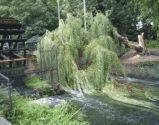 Now you see it ..
Now you see it ..Definitely for the worse, the magnificent weeping willow opposite the Wheelhouse came to a dramatic end last Saturday - shortly after the market opened a loud crack was heard, startling everyone. As the photos show, it cracked just above the ground, a victim of internal decay. By this weekend, it had been removed with great skill and neatness by a LBM team. Some would say it has opened up the view. I will miss the tree.
Abbey Fest
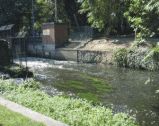 Now you don’t..
Now you don’t..Abbeyfest remains a great attraction, and has been well supported this year despite the weather. A new innovation is Kidsfest this Bank Holiday Monday, which will include Dave Saxby laying on an architectural dig for the children.
KFC.
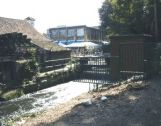 But now you do. - the new
vista
But now you do. - the new
vistaEverytime I visit the Mills, there is something new. Some of it not for the better. There are signs that KFC has obtained permission to create a drive through collection, and the diggers were there to be seen this weekend. I don’t remember seeing this proposal advertised (only an application for an illuminated sign) and remain sad that there is not an automatic referral of any planning application on the MAM site to the various heritage bodies in Merton.
Ed

House Mill, Bromley by Bow, Members Visit
Eric Shaw reports:
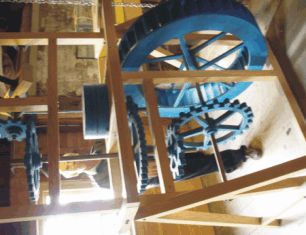 Brian Strong demonstrates a model showing how the
various cogs of a waterwheel interact
Brian Strong demonstrates a model showing how the
various cogs of a waterwheel interactOn Thursday 6th July, 10 members visited the House Mill at Three Mill Lane at Bromley by Bow. After a short introductory talk we were taken round the Mill by Brian Strong, volunteer of the River Lea Tidal Mill Trust.
The Mill is now the largest tide Mill in the UK and is grade one listed. It appears to be brick built but the front and sides are just a facade and it is actually a timber framed building and built to five levels.
The machinery inside is no longer working, but in the long-term it is hoped that it will be restored in working order including the Mill wheels.
Several hours was spent on the tour and those who couldn't come missed a fascinating afternoon. I, for one, would go again if ever the chance arrives, furthermore I recommend any other member, if they get the chance, not to miss a visit. Several photos were taken so you may get the chance to see what you missed. One question. How is the name of the River correctly spelt? In the various publications available it appears either as Lea or as Lee.
Eric Shaw July 2007
NB
I was idly looking through a copy of Greater London Industrial Archaeology number 7 booklet from our records in the Museum. Imagine my surprise and pleasure at finding an article on the Fairbairn style machinery the House Mill Bromley by Bow London E3. It was written by Brian Strong who was our guide on the visit. The article goes into much more detail, with illustrations, than was available to us and explained in greater detail the workings of Fairbairn's “silent mill machinery”. Something that I certainly didn't understand from our visit.
It has strengthened my resolve to visit the site again in the future because of the greater understanding which I now have of what I would see on my next visit.
Eric Shaw August 2007
Incidental information about House Mill.
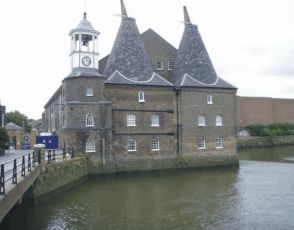 Clock Mill, the third Mill on the island currently just
houses offices
Clock Mill, the third Mill on the island currently just
houses offices
The mill complex sits on a small man-made island where two branches of the River Lea meet. Alongside runs the River Lea navigation. As with stretches of the river Wandle and various other rivers in England a ‘navigation’ is a stretch of river which has been artificially widened and straightened to encourage water transport, while still remaining a river. A series of weirs rather than locks maintain the height of the river where necessary. Currently this section of the navigation is covered in weed, but we were told that it is one of the plans in the development of the Olympic Park (which starts just above House Mill along the River Lea Valley) that most of the building material will be transported to it along the navigation. Each barge will be able to carry 100 tonnes of material and in doing so will save 50 or more lorry trips and the resultant risks of pollution. Unfortunately making the River fully navigable again is taking a little time and it will not be ready in time to remove the waste that will be created as the site is cleared. Whilst we were visiting the Mill a constant pile driving sound in the background was evidence of the work in constructing the new weirs that will make the River fully navigable again.
I have mentioned that this is a man made island. Evidence for this came as a surprise at a time when Thames Water was laying a new water main through the island immediately before the restoration of the Mill buildings. It was quite clear that the outer rim of the island was standard marshy soil, but inside was material that had clearly come from somewhere else and was surrounded by post and postmarks to show how it had been contained when it had been constructed. There is no history for this, but it is likely to have gone back to medieval times.
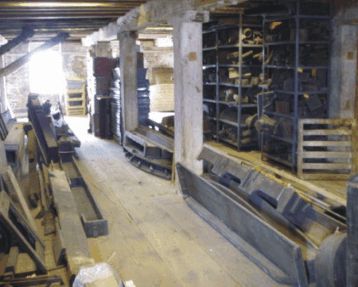 The floor where the forms are now stored - none of these intricate
shapes is iron - they are all made of wood
The floor where the forms are now stored - none of these intricate
shapes is iron - they are all made of woodLinked to this the construction of the mills was also interesting. As Eric has said they appear to be brick built but in fact the brick covers a solid timber framed building inside. When they were clearing the Miller's building prior to its reconstruction they discovered that there were no foundations as such merely 12ft long poles driven hard into the ground and left with a small clearance of a couple of inches, on top of which planks were laid and then the bricks laid on top of those planks. Creative building techniques have clearly been around for a very long time !
Of direct interest to our own future at Ravensbury Mill, are the water wheels themselves. Three of the four wheels are Poncelot wheels of which the largest is eight foot across. This compares with the two 4ft wheels at Ravensbury. Brian Strong was telling us that if this wheel alone was restored it could deliver 40 horsepower, and, if connected to the National Grid would generate a significant income for the Mill Trust. Our two wheels at Ravensbury, once restored, will clearly deliver a significant return unto us as well if we follow their example.
The House Mill wheel is ‘lower breast shot’, rather than ‘undershot’, but that should not make any significant difference.
A curiosity was a room full of what appeared to be a huge selection of cast iron spare parts for the operation of the mill machinery. What these pieces were actually made of was wood! These turned out to be the forms used to create the moulds from which the real cast iron replacements for worn out machinery could be made. English Heritage has helped the trust label and list these, but, as yet, they have not had the resources to work out how they all fit together.
Ed
Mills of the Wandle - Update
Peter McGow has been kind enough to write with further information about Mill 44 (the Dyeworks , in what is now Mapleton rescent, Wandsworth) :
“Dear Nicholas,
I have a little further information relating to Mill 44, obtained from various editions of Kelly's Directories, which fills a couple of gaps, and confirms that Richard Bell was an early match maker.
In my account I wrote that Richard Bell was first mentioned as a match maker there in 1851, but surmised that he may have been making matches in 1834. In fact, Bell's firm, which later became R.Bell & Company Ltd., began making matches in 1832.
This information was given in various editions of Kelly's Directories for the 1890s and later, in which the company thereby claimed to be "The oldest match making firm in the Kingdom". Actually, it was then the oldest surviving firm. There had been a few earlier match makers, one of whom coined the name "lucifer" which Richard Bell adopted.
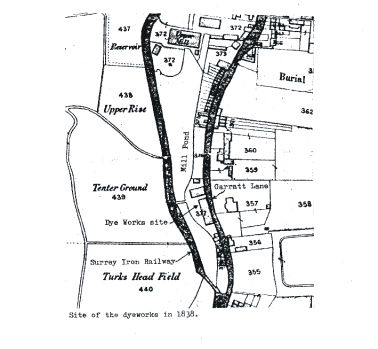
The company retained their works at Wandsworth until 1889,but by 1884 they also had offices in Knightrider Street in the City of London, and later also in Queen Victoria Street. In 1890 the works and offices were transferred to Bell Road, St.Leonard's Street, Bromley- by- Bow. The firm would seem to have continued working until about 1920.
My investigation was prompted by some information given in a book I came across, "The Match Makers" by Patrick Beaver, which contains a photograph of some boxes of matches preserved in the Science Museum. One of these boxes is labelled “R.Bell's Improved Lucifers" and was ascribed to 1833. It was also stated that "Bell was the first manufacturer to devote himself entirely to matches".
Bell's successor at the works, Joseph Freeman, Sons & Company, moved to there in 1892, having previously occupied the Grove Works, Lombard Road, Battersea.
Every little helps:
Sincerely,
Peter McGow “
The World’s First Railway.
An interesting exchange of correspondence in the Letters columns of the Times was sparked by an off hand remark as to the Liverpool and Manchester line being the world’s first passenger line.
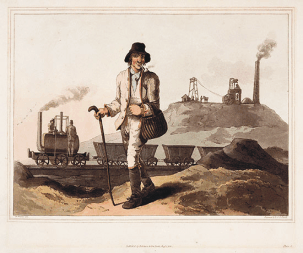 “The Collier” - Middleton Railway 1814
“The Collier” - Middleton Railway 1814Over the next week various contributors opined on this, revelling in minor terminological variations. So far as I can tell, the following summarises the conclusions:
1758 - Middleton Railway - first railway to be granted powers by Act of Parliament. It operated initially as a wagonway using horse-drawn vehicles.
1803 - Surrey Iron Railway - first public railway. Always horse drawn, goods only.
1807 - Swansea and Mumbles - first passenger railway. Horse drawn until 1877. The line started as a goods train service in the spring of 1806.
1812 - Middleton Railway (again) - first commercial railway to successfully use steam locomotives. Not a public railway until much later.
1825 - Stockton and Darlington - first public railway to use steam locomotives. Originally a freight line (the carrying of passengers in 1825 was a one-off).
1830 - Whitstable and Canterbury - first steam public passenger railway. Opened in May. (Nicknamed the old "Crab and Winkle"). Before then it ran as a horse railway. As a steam-powered passenger railway it is just older than L&M., which opened later that year.
1830 - Liverpool and Manchester - first main line (or modern) railway. The first to run trains carrying passengers running to a published timetable, for which members of the public could purchase tickets.
This was clearly a UK based debate, so this summary may or may not represent ‘world’ firsts, but is interesting in its own right.
Nicholas Hart August 26, 2007
ANGLING DIVERSIONS
An extract
The River Wandle, which rises near Croydon and flows into the Thames at Wandsworth, was at one time one of the finest trout streams in England and was celebrated for the size of its fish.
Wandle's waters must have been exceptionally clear, for was it not "the blue transparent Vandalis" of Pope and the stream of which a Carshalton poet wrote:
The Wandle's a river that hereabout rises,
Its wonderful clearness the stranger surprises. That it remained so pure and silvery is remarkable since from an early date factories were to be found along its whole length. Even in 1805, according to Malcolm's Compendium of Modern Husbandry, it supported 12 calico works, 9 flour mills, 5 snuff mills, 3 bleaching grounds, 5 oil mills, 2 dyeing works, a paper mill, a skinning mill, a logwood mill, a copper works and a porter brewery; forty-two plants on a river less than eight miles in length, which between them employed some three thousand people, and yet it still remained a first-class trout stream!
It was the river from which Izaak Walton fished for trout" marked with marble spots like a tortoise" and also from which Horatio Nelson took many a good fish at Merton. Another well-known angler who regularly fished the Wandle was T. C. Hofland, the originator of that once most popular fly, "Hofland's Fancy." In 1839, writing of this river, he said: "If the day be bright, I generally approach the bank of the river in a stooping position and when at a proper distance, kneel upon one knee, to cast my fly. This is necessary because the water is as clear as a north country beck."
Up to the "eighteen hundred and sixties," trout of two to three pounds in weight were almost every-day captures, and at a little earlier date, a Mr. Lemann, fishing about half-a-mile above Hackbridge, landed three trout in one afternoon, not one of which was under six pounds. All of them fell to a large Coachman.
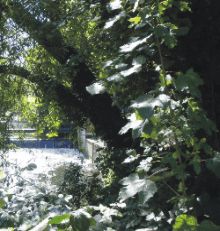 The weir at Merton Abbey Mills as we
can now see it
The weir at Merton Abbey Mills as we
can now see itThe quality of the fishing around this period may be judged by the catch made in one season of four months' fishing, by Mr. Charles Hudson of Mitcham, which consisted of over four hundred brace of trout. Most of the larger fish were taken at dusk on a large Alder (with silver twist) and with a small shot pinched on the gut close to the fly - a method which will hardly commend itself to the purist.
It was about this time, too, that Halford was fishing the Wandle, but goodw fisherman as he was, he never equalled the best catch of that great all-round angler, Alfred Jardine. This was made in May, 1874, when in five hours' fishing he creeled nine brace of trout with a total weight of 32 lb., the largest brace weighing respectively 3 lb.10 oz. and 3 lb. 6 oz.
Even by then, the average size of the fish had been declining for some time, a process which was to continue, for at a little later date we find Mr. C. P. Hooker writing:
"My acquaintance with the Wandle was limited to a small portion, namely a garden at Hackbridge. . . . During the summers of 1876-7, I spent most of my Saturday afternoons there and usually caught (on the Coachman) from four to ten fish of an average size of about 3/4lb. On May 19, 1877, I caught no less than 32 fish. I thought then, and still think, that I never saw more handsome shapely trout anywhere."
Doubtless the decrease in size of the trout was due to their food supply being affected by the gradual but ever increasing pollution. By 1905, a newspaper reported that "Wandsworth knows the Wandle as a sickly stream, sage green and sluggish, soiled by a dozen factories, and often smelling vilely."
Even after that, the river put up a great fight for its existence as a trout stream, but all in vain. Twenty-four years later a committee of working men anglers drew up a report of which the following extract will suffice: "No fish could survive in the Wandle nowadays; they would immediately die from poisoning. The once clean, swiftly- moving waters are now black and muddy, cluttered with evil-smelling, putrescent flotsam, and rendered foul and malignant by the outpourings of industrialism. The river has not merely been neglected; it has been deliberately, wantonly, turned into a kind of open sewer. The bottom is littered with old tin cans, scraps of iron, broken bottles, and miscellaneous rubbish of all kinds."
Five years more and the very last Wandle trout fell a victim to a bait fisherman. No trout had been seen in the river for several years and the capture of this lone specimen was therefore all the more unexpected. It was almost as if this stout-hearted little river was saying to those who had cared for it so little and had treated it so disgracefully "Look, for the last time, upon a Wandle trout and see what sport I might have provided, had a fair chance been vouchsafed me," for the fish it provided as its final gesture was a magnificent specimen 22 inches in length and scaling 5 3/4 lb. I Thus did a grand trout and a grand river die together. Thus, too, did the once beautiful and fast- flowing Wandle, a prince amongst the trout streams of the British Isles, succumb to the march of industry.
The tragedy of the Wandle is the tragedy of many other southern rivers, which to-day remain only as scathing indictments of the responsible authorities. There is neither need nor justification for any industrial concern or other undertaking to foul and destroy a lovely river; their action in so doing is merely an easy and cheap expedient for getting rid of their waste products and sewage, with the least possible trouble to themselves. In a properly ordered society such vandalism would never be permitted.
from “Angling Diversions” by A Courtney Williams, first published c1940. Our thanks to Dave Roberts for spotting this.
NB - While the current clean state of the Wandle is much improved from the scenario described above, the recent pollution incident in Carshalton shows how precarious this is. That event seems to have been very localised, and, hopefully (apart from some very confused fish who have been introduced to domestic bathing) will not have long term effects. Ed
The Vestry Hall Annexe, London Road, Mitcham, Surrey CR4 3UD
Tel: 020-8648-0127
~~~~~~~~~~
OPEN: Every Wednesday 1 ~ 4 pm;
First Sunday of each month 2 ~ 5 pm.
~~~~~~~~~~
The Museum is also open to schools and groups by appointment.
~~~~~~~~~~
Admission: Adults 50p, Children & Senior Citizens 20p
The Wandle Industrial Museum would like to point out that the views of contributors to this newsletter are not necessarily the views of the Museum. We would be happy to give the right to reply to anyone who finds the content contentious.
